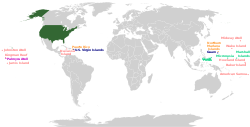Territory of the United States
|
Territories of the United States
|
|
|---|---|

|
|

The 50 states and the Federal District
Commonwealth (see footnote)
Incorporated unorganized Territory
Unincorporated organized territory
Unincorporated unorganized territory
|
|
| Largest settlement | San Juan, Puerto Rico |
| Languages | English, Spanish, Hawaiian, Chamorro, Carolinian, Samoan |
| Demonym | American |
| Territories | |
| Leaders | |
| Donald Trump | |
| List of current territorial governors | |
| Area | |
|
• Total
|
22,294.19 km2 (8,607.83 sq mi) |
| Population | |
|
• Estimate
|
4,065,516 |
| Currency | United States Dollar |
| Date format | mm/dd/yyyy (AD) |
|
|
Territories of the United States are sub-national administrative divisions directly overseen by the United States federal government (unlike U.S. states, which share sovereignty with the federal government). These territories are classified by whether they are incorporated (part of the United States proper) and whether they have an organized government through an Organic Act passed by the U.S. Congress.
Currently, the United States has sixteen territories, five of which are permanently inhabited: Puerto Rico, Guam, the Northern Mariana Islands, the U.S. Virgin Islands, and American Samoa. They are classified as unincorporated territories. They are organized, self-governing territories with locally elected governors and territorial legislatures. Each also elects a non-voting member (or resident commissioner) to the U.S. House of Representatives. Eleven territories are small islands, atolls and reefs, spread across the Caribbean and Pacific, with no native or permanent populations. These are Palmyra Atoll, Baker Island, Howland Island, Jarvis Island, Johnston Atoll, Kingman Reef, Midway Islands, Bajo Nuevo Bank, Navassa Island, Serranilla Bank and Wake Island, which are claimed by the United States under the Guano Islands Act of 1856. The status of some are disputed by Colombia, Haiti, Honduras, Jamaica, Nicaragua, and the Marshall Islands. The Palmyra Atoll is the only territory currently incorporated.
...
Wikipedia
